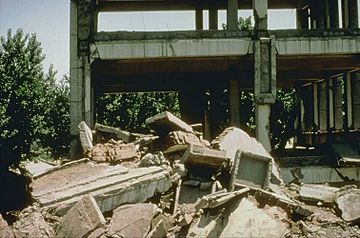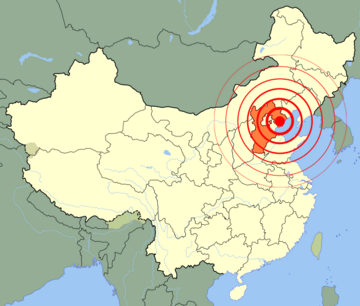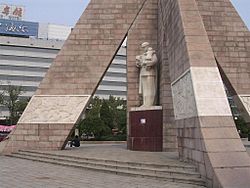1976 Tangshan earthquake facts for kids
 |
|
 |
|
| UTC time | Doublet earthquake: |
|---|---|
| A: 1976-07-27 19:42:55 | |
| B: 1976-07-28 10:45:36 | |
| ISC event | |
| A: 711732 | |
| B: 711773 | |
| USGS-ANSS | |
| A: ComCat | |
| B: ComCat | |
| Local date | 28 July 1976 |
| Local time | Peking time: |
| A: 03:43 | |
| B: 18:45 | |
| Magnitude | |
| A: 7.6 Mw; 7.6 Ms | |
| B: 7.0 Mw; 7.4 Ms | |
| Depth | A: 12.2 km B: 16.7 km |
| Epicenter | 39°38′N 118°06′E / 39.63°N 118.10°E 39°43′N 118°26′E / 39.72°N 118.44°E |
| Max. intensity | XI (Extreme) |
| Casualties | 242,419 to 655,000 |
The 1976 Tangshan earthquake (Chinese: 唐山大地震; pinyin: Tángshān dà dìzhèn; lit. 'Great Tangshan earthquake') was a very strong earthquake. It hit the area around Tangshan, Hebei, China. The main shock happened at 3:42 a.m. on July 28, 1976. Its strength was measured at 7.6 on the moment magnitude scale.
The earthquake was incredibly powerful. It caused 85 percent of buildings in Tangshan to collapse. All city services, like electricity and water, stopped working. Most roads and railway bridges were also destroyed or badly damaged. The official report stated that 242,769 people died. Another 164,851 people were seriously injured. When including missing people and those who died later, the total number of deaths is believed to be at least 300,000. This makes it one of the deadliest disasters in China's history.
Contents
What Caused the Earthquakes?
The Tangshan earthquake was actually two main shocks. The first one hit at 3:42:56 a.m. It happened about 12 kilometers (7.5 miles) under the southern part of Tangshan. Scientists first thought it was magnitude 8.1, but later changed it to 7.6.
This earthquake happened on a type of fault called a "strike-slip fault." This means the ground blocks slid past each other sideways. One side moved about three meters (10 feet) to the southwest. This movement was caused by huge forces pushing the Earth's crust together.
The second main shock happened later that day at 6:45 p.m. It was near Luanxian, about 70 kilometers (43 miles) east of Tangshan. This shock had a magnitude of 7.0. It happened on different faults that crossed the main Tangshan fault. This suggests that the land between these two earthquakes was being squeezed out to the south.
Aftershocks and Ongoing Activity
After the main shocks, many smaller earthquakes, called aftershocks, followed. Twelve of these aftershocks were magnitude 6 or stronger. The first big aftershock hit just three and a half hours after the main quake. Many buildings that were still standing were damaged even more by these aftershocks.
The area where these aftershocks happened is still active today. Smaller earthquakes, around magnitude 4.5 to 5.1, have occurred in recent years. For example, a 5.1 magnitude earthquake hit in July 2020. It caused only minor damage. Scientists are still discussing if these recent quakes are still aftershocks from 1976 or new, separate earthquakes.
How Much Damage Did It Cause?
The amount of damage from an earthquake depends on two main things. First, it depends on how strong the shaking is. This shaking is affected by the earthquake's size, how far away you are from it, and the type of soil. Soft soils, like sand, can make the shaking worse. Second, it depends on how buildings are designed and built. Buildings made of mud brick or stone, or those without strong frames, are very easily damaged.
Tangshan was mostly built with brick buildings that were not reinforced. This means they didn't have extra support to withstand earthquakes. The city was also located right on top of a major fault line. The earthquake was so strong it was felt up to 1,100 kilometers (680 miles) away. This included most of northeastern China, Mongolia, and even Korea. In Beijing, about 140 kilometers (87 miles) from Tangshan, nearly 10% of buildings were damaged. At least 50 people died there. The total economic loss was about 10 billion Chinese yuan.
Extreme Damage Zones
The earthquake's rupture happened directly under the southern part of Tangshan. The fault then spread northeast through the city center. The shaking was so intense that it reached "XI" (eleven) on the 12-degree Chinese scale. This is considered "Extreme" damage.
Almost every building in Tangshan collapsed or was badly damaged. Important services like electricity, water, and communication were completely shut down. This area of extreme damage was about 10.5 kilometers (6.5 miles) long. It was also 3.5 to 5.5 kilometers (2 to 3.4 miles) wide, mostly along the railway.
In the next zone, where shaking was "X" (ten), only new, one-story brick buildings were just "damaged." All other buildings were severely damaged or destroyed. This zone was 36 kilometers (22 miles) long and 15 kilometers (9 miles) wide. Out of 25 highway and railway bridges in this area, only six had minor damage.
Severe and Moderate Damage Zones
Shaking of intensity IX (nine) or greater happened in a zone about 78 kilometers (48 miles) long and 42 kilometers (26 miles) wide. In this zone, most well-built buildings survived. However, many older wooden buildings and most buildings made of mud brick or stone were destroyed.
Further out, in the intensity VIII (eight) zone, shaking mostly affected mud brick or stone buildings. More than half of these were destroyed. Bridges and tall brick chimneys were also damaged. Railway tracks could bend or move, depending on the soil.
The intensity VII (seven) zone marked where moderate damage occurred. Many weak structures were damaged, but only a few were destroyed. This zone stretched about 75 kilometers (47 miles) north and south of Tangshan. It also went 120 kilometers (75 miles) east and west.
Impact on Coal Mines
Tangshan's main industry was coal mining. When the earthquake hit, about 10,000 miners were underground. Luckily, most of the mine tunnels were not badly damaged. However, without electricity, there were no lights, no fresh air, and no working elevators. Most miners escaped within hours. Some were stuck underground for up to two weeks.
The main problem for the mines was flooding. The top 50 meters (164 feet) of the vertical shafts were damaged. Concrete linings that kept water out cracked, letting in a lot of water. With no power for pumps, many mines filled with water. Some electricity was back in three days, and coal production started again in ten days. But it took a year and a half to fully repair everything. The mines didn't reach their normal production levels until the end of 1977.
Impact on Railways
The main railway lines connecting Beijing, Tianjin, and Tangshan were severely damaged. These railways were not built to withstand earthquakes. At the time of the main quake, 28 freight trains and seven passenger trains were on the Beijing–Shanhaiguan line. Seven freight trains and two passenger trains went off the tracks. This happened mostly where the line was built on loose soil.
In many places, the railway tracks buckled because of the ground movement. Railway operations were also hurt by the loss of communication and water for steam trains. The most serious damage was to bridges. Soft soil caused bridge supports to slide into rivers. In other cases, the ground leading up to bridges sank, leaving the tracks hanging.
Over 42,000 people were quickly brought in to repair the railways. One line was open for traffic in just six days. The main Beijing-Shanhaiguan line had one track open in ten days, and both tracks open in 13 days. However, trains had to go slowly over temporary bridges and other repaired areas.
How Many People Died?
The official report stated that 242,769 people died. It also said 164,851 people were seriously injured in Tangshan. However, when counting missing people and those who died later, experts believe at least 300,000 people died. This makes it the deadliest earthquake in China's history. It is also among the top deadliest disasters in China. Unofficial estimates of the death toll varied widely.
Official Figures
A book from 1988 by Chinese scientists reported 242,419 deaths. This matches the official number from the state news agency. A Chinese Earthquake Administration website from 2009 also confirmed 242,769 deaths and 164,851 serious injuries. As of 2017, the Tangshan Earthquake Memorial Wall lists the names of 246,465 victims. These names were added by their families.
Political Impact
The Tangshan earthquake happened during a time of political change in China. This period was called the Cultural Revolution. In traditional Chinese belief, natural disasters like earthquakes were sometimes seen as signs. People believed they could mean the government had lost its "mandate of heaven" (its right to rule).
The government had successfully predicted the 1975 Haicheng earthquake the year before. This was seen as proof that their methods worked. It also showed the strength of their socialist system. However, the Tangshan earthquake was not predicted. This was a big shock, both for the people and for the government.
Despite the disaster, the government quickly organized a huge rescue and relief effort. They sent resources from all over the country. This showed their ability to help people and restore normal life. This was different from how disasters were handled in the past. Back then, poor people often received little help.
Mao Zedong, China's leader, was already very ill when the earthquake happened. He died just six weeks later, on September 9, 1976. His death led to the end of the Cultural Revolution.
Why Did it Happen There?
Tangshan is located at the northern edge of the Beijing-Tianjin-Tangshan Plain. This is a flat area formed by sediments from the Yanshan mountains. These sediments filled in an ancient sea. In Tangshan, these sediments are thinner, but to the south, they can be up to three kilometers (1.9 miles) thick.
Underneath these sediments is a thick layer of rock, including limestone and sandstone. This layer contains large coal deposits. Tangshan sits over a fold in these rock layers called a "syncline." This fold brings the coal close enough to the surface to be mined.
Below all this is very old bedrock. This bedrock forms the Eastern Block of the North China Craton. This craton was formed about two billion years ago when two large land blocks collided. This collision created mountains and made the area very active with earthquakes. Six of the ten deadliest earthquakes in history have happened in this region.
The Tangshan fault, which caused the 1976 earthquake, runs right under the center of Tangshan City. It is considered a shallow fault. This means it is closer to the surface, which can cause more intense shaking.
Was It Predicted?
Whether the Tangshan earthquake was predicted is a big question. It has been important for both politics and earthquake science. The 1975 Haicheng earthquake was successfully predicted. This led to fewer deaths because people were warned and took safety steps. This success was celebrated in China.
However, Tangshan was not so lucky. There were no clear warnings, and the city was completely unprepared. This led to a much higher death toll. Many scientists believe the Tangshan earthquake was not predictable. They say there were no unusual signs before it happened. Also, an investigation 30 years later found no official short-term prediction for Haicheng either. The warnings there were mostly local and based on general ideas and small foreshocks. Tangshan had no noticeable foreshocks.
Some reports say that scientists at the State Seismological Bureau wanted to warn about an earthquake. They discussed it at meetings. One scientist reportedly warned of a magnitude 5+ earthquake in the Tangshan area. But there was disagreement within the bureau. Some thought the next big earthquake would be in western China. It turned out western China was hit by a magnitude 7.2 earthquake three weeks after Tangshan.
There was also concern about causing panic with false alarms. Many predictions at the time were based on doubtful theories. They often led to warnings that were too broad or inaccurate. For example, a false alarm in 1976 in Shaanxi province disrupted the lives of 65% of the population for half a year. This shows the challenge of earthquake prediction: trying to predict every quake can lead to many false alarms, which can be very costly and disruptive.
How Does It Compare to Other Earthquakes?
Comparing the Tangshan death toll (officially 242,419) to other earthquakes is hard. This is because numbers can be uncertain. For example, the 1556 Shaanxi earthquake is often called the deadliest. It is said to have caused 830,000 deaths. However, some sources say only 530,000 died directly from the quake. The higher number might include deaths from disease and famine afterward.
Other very deadly earthquakes in history include:
- The 1138 Aleppo earthquake (Syria) with about 230,000 deaths.
- The 2004 Sumatra earthquake (Indonesia) with 227,898 deaths, mostly from tsunamis.
- The 2010 Haiti earthquake with 100,000–316,000 deaths.
- The 1920 Haiyuan earthquake (China) with 200,000–273,400 deaths.
- The 856 Damghan earthquake (Iran) with about 200,000 deaths.
Unlike many other disasters, Tangshan did not have major problems from fires, tsunamis, landslides, or floods. A large dam near Tangshan was damaged but did not break. The quick and massive response from the government helped save thousands of lives. They also quickly provided clean water, food, and health care. This prevented many deaths from disease and starvation that often follow such disasters.
Images for kids
See also
 In Spanish: Terremoto de Tangshan de 1976 para niños
In Spanish: Terremoto de Tangshan de 1976 para niños
- List of earthquakes in China
- List of disasters in China by death toll
- List of earthquakes in 1976
- Tangshan Earthquake Memorial Park





